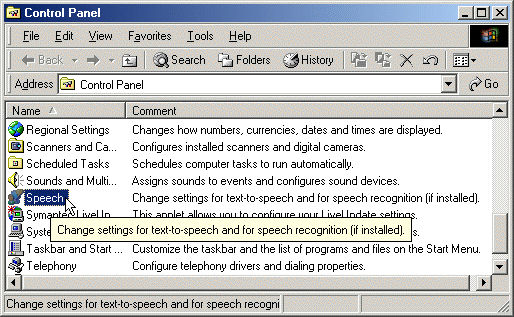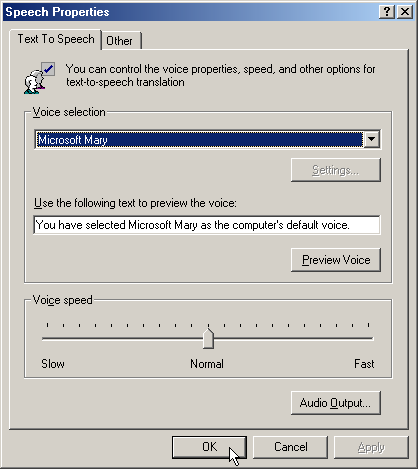

WorkWORLD
 |
 |
||||
| Get Latest WorkWORLD |
|||||
|
|
www.workworld.org |
workworld@vcu.edu |
This topic provides information about controlling the text-to-speech synthesizer properties used by WorkWORLD and your computer, such as the voice used, and the rate and volume of the speech. You may also find this information useful if you need to troubleshoot your computer's text-to-speech setup.
When you install WorkWORLD, a new item named Speech is created in your computer's Control Panel if it was not already present. All of the speech properties may be set from within that by following the instructions below.
This remainder of this topic consists of several sections. You may read them all sequentially, or jump immediately to one of them by following the bulleted links below to the sections listed:
· To open Speech in Control Panel
· To determine the selected text-to-speech voice
· To preview the text-to-speech voice
· To change the text-to-speech voice
· To change the text-to-speech voice rate
· To select an audio output device
· To change the text-to-speech volume
You must open Speech in Control Panel in order to determine or change any Speech Properties. Two methods are described to open it, first using only the keyboard and then using the mouse.
From the keyboard, press the Windows Start button on the taskbar or use the Windows Start key on the keyboard. Use the arrow keys to select Settings, then press Enter. Use the arrow Keys to select Control Panel, then press Enter. Use the arrow keys to select Speech in Control Panel, then press enter.
Using a mouse, click Start, point to Settings, click Control Panel, and then double-click the Speech icon.

After using either of the above methods, the Speech Properties window will appear, allowing you to control any of the items discussed below.

Open Speech in Control Panel, as described above.
On the Text-to-Speech tab, the displayed name in the Voice selection drop-down list box is the current active voice.
Click Preview Voice to hear the active voice; the text will be spoken, highlighting the words as they are spoken.
Open Speech in Control Panel, as described above.
On the Text-to-Speech tab, the displayed name in the Voice selection drop-down list box is the active voice.
Click Preview Voice to hear the currently selected voice; the text will be spoken, highlighting the words as they are spoken. During playback, Preview Voice will change to Stop. Click Stop to interrupt the voice playback.
Note: You can change the text to be read by the Preview Voice by highlighting the text and typing in new text. These changes are not permanent and when you reopen Speech properties or select a different voice, the text will reset to the default.
Open Speech in Control Panel, as described above.
On the Text-to-Speech tab, the name displayed in the Voice selection drop-down list box is the active voice.
Click the active voice inside the drop-down list box, or use the arrow to display a list of available voices.
Click a new voice to select it.
The newly selected voice will speak using the text in Preview Voice box.
Click OK or Apply to accept the new voice.
Open Speech in Control Panel, as described above.
Select the Text-to-Speech tab.
Move the Voice speed slider to change the rate of the text-to-speech voice. By default, it is set to normal.
Click Preview Voice to hear the currently selected voice at the new rate; the text will be spoken, highlighting the words as they are spoken.
Open Speech in Control Panel, as described above.
On the Text-to-Speech tab, click Audio Output.
Select either Use preferred audio output device or Use this audio output device.
Use preferred audio device sets the output device as the default for the system. Select this option if you want to use the same output device for speech as all other sound for the system. It is also the default option for Speech properties. Often, computers will have only one output device, such as a pair of speakers. The default device is designated in the appropriate sounds or multimedia properties in Control Panel for each operating system. Additional information for the specific panel is available through the associated Help files.
Use this audio output device allows you to select another device for speech applications only. The drop-down list box is active if other devices are available. From this drop-down list, select the device you want. This does not change the default device for other audio applications. For example, you may want all speech output to go through your headset rather than the speakers.
To adjust the volume output levels, follow the procedure below. However, not all devices support this option in the same way. Some devices will not support volume control and the Volume button will be unavailable. Other devices may use their own display. In those cases, follow the instructions presented on the screen or documented separately with the engine.
Open Speech in Control Panel, as described above.
On the Text-to-Speech tab, click Audio Output, and then click Volume.
A volume control mixer will be displayed. Adjust the appropriate device to the required level.
Additional information about WorkWORLD speech is available by following the bulleted links below to the topics listed:
· WorkWORLD Speech - Turning On or Off
· WorkWORLD Speech - Operation
· WorkWORLD Speech - Keyboard Commands
· WorkWORLD Speech - Using with JAWS
WorkWORLD™ Help/Information System
![]() Share/Save: Click the button or link at left to select your favorite bookmark service and add this page.
Share/Save: Click the button or link at left to select your favorite bookmark service and add this page.
This is one topic from the thousands available in the WorkWORLD™ software Help/Information System.
Complete information about the software is available at: http://www.WorkWORLD.org
See How to Get WorkWORLD page at: http://www.WorkWORLD.org/howtogetWW.html
NOTE: Sponsored links and commercial advertisements help make the WorkWORLD™ website possible by partially defraying its operating and maintenance expenses. No endorsement of these or any related commercial products or services is intended or implied by the Employment Support Institute or any of its partners. ESI and its partners take no responsibility for, and exercise no control over, any of these advertisements or their views or contents, and do not vouch for the accuracy of the information contained in them. Readers are cautioned to verify all information obtained from these advertisements prior to taking any actions based upon them. The installed WorkWORLD software does not contain advertisements of any kind.
Copyright © 1996, 1997, 1998, 1999, 2000, 2001, 2002, 2003, 2004, 2005, 2006, 2007, 2008, 2009, 2010, 2011, 2012, Virginia Commonwealth University. All rights reserved.